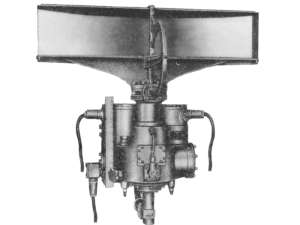Type 268
Description of the radar set, tactical-technical characteristics

Figure 1: “Cheese antenna” of the radar Type 268 B
| Specifications | |
|---|---|
| frequency: | 9 320 … 9 475 MHz
(X-Band) |
| pulse repetition time (PRT): | |
| pulse repetition frequency (PRF): | 500 Hz |
| pulsewidth (τ): | 0.75 µs |
| receive time: | |
| dead time: | |
| peak power: | 30 kW |
| average power: | 15 W |
| instrumented range: | 30 NM (≙ 55 km) |
| range resolution: | 100 m |
| accuracy: | |
| beamwidth: | 2.5° |
| hits per scan: | |
| antenna rotation: | 22 min-1 |
| MTBCF: | |
| MTTR: | |
Type 268
The Type 268 was an operating in X-Band search, navigational and target-indication radar developed in Canada for the British Admiralty in 1944. It permitted detection of a battleship at 9 NM and a submarine snorkel at 3 NM. Since 1945 the radar was installed in coastal forces.
The antenna was of the “Cheese antenna” type, not stabilized against pitch and roll. The transmitter used a magnetron of type 725A.
